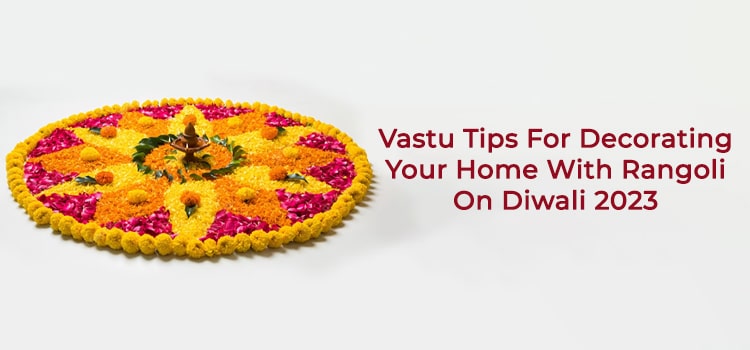Vastu Tips to Decorate Your Home with Rangoli On Diwali 2023
Diwali is India’s own festival of lights. Vibrant and colorful Rangolis are often used to augment the mood of Diwali. They add beauty and elegance to the festive arrangements, and they are very auspicious, too. Rangolis are also very important in Vastu Shastra. As per astrology, the placement of Rangolis can create a positive energy flow in your house. One can follow Vastu tips to decide how one can place Rangolis during Diwali 2023. They will help create more harmony and auspiciousness in your life.

The colors used in a Rangoli must be bright and vibrant. As per Vastu, red, orange, yellow, and green colors are auspicious for Diwali Rangoli. They represent growth, prosperity, and positivity.
People usually make Rangoli using rice flour, colored powder, and flowers. However, as per Vastu, natural and organic materials are better. They include turmeric, vermilion, and sandalwood powder. These are believed to have cleansing and purifying powers that attract positive energy.
The direction in which you make Rangoli is also important. One should make Rangoli in the north, east, or northeast direction of the house. This will help attract wealth, health, and prosperity.
One can include auspicious symbols like the swastika, Om, and lotus in the Rangoli. These create a positive energy flow.
The Rangoli’s size and shape must be proportional to the house’s size and shape. It is better to have a circular or oval shape for the Rangoli as they signify completeness and wholeness.
When you use the right colors, materials, and symbols in your Diwali Rangoli, it can boost the positive energy flow in your house. This attracts good luck, prosperity, and happiness.
Where to make the Rangoli? Some Vastu Tips
Choosing the right location for your Diwali Rangoli matters. This will attract positive energy and good luck, say Vastu experts. Here are some tips.
The entrance of your house is the best location to place the Rangoli, according to Vastu. This can attract positive energy into the house, bringing good fortune, wealth, and prosperity. Do not place the Rangoli at the entrance of the toilet or bathroom, as this is inauspicious.
The Pooja room is also auspicious for placing the Rangoli, as per Vastu. It boosts the flow of positive energy and brings peace, harmony, and prosperity. The Rangoli should not block the path to the Pooja room.
The northeast corner is the most auspicious location to place the Rangoli. It can bring positive energy and good luck. But do not place it in the southwest corner, as this is inauspicious.
The living room is also an auspicious place for the Rangoli as it enhances the positive energy flow. But it should not block the path or cause any inconvenience to the people residing in the house.
The balcony or terrace is also an ideal place for the Rangoli. But do not place it in the south or west direction.
Vastu-prescribed Rangoli designs for Diwali 2023
· Swastika
The swastika is a popular and auspicious symbol in India. It signifies good fortune, prosperity, and positivity. A Rangoli design resembling a swastika can attract positive energy, as per Vastu.
· Lotus
The lotus, in Indian religion and culture, is a sacred symbol that denotes purity, spirituality, and enlightenment. A Rangoli design resembling a lotus boosts the positive energy flow and brings peace and harmony.
· Diya/Lamp
Diya, or lamp, is used during Diwali to symbolize the victory of light over darkness. Making a Rangoli design resembling a diya brings positive energy flow into the house. It boosts good luck and prosperity.
· Peacock
Peacock represents beauty, grace, and elegance. Peacock design Rangoli is auspicious, as it attracts positive energy into the house.
· Ganesha
Ganesha is a Hindu deity who represents wisdom, intelligence, and good luck. A Rangoli design resembling Ganesha is very auspicious. It creates a positive energy flow and generates good luck, prosperity, and happiness.
Benefits of making Vastu-based Rangoli
Making Rangoli according to Vastu principles during Diwali has many benefits. Let us see what they are:
It Attracts Positive Energy: It attracts positive energy and increases the positive energy flow in the house, thereby bringing luck, wealth, and prosperity.
It Boosts Aesthetics: It is a lovely art form that boosts the aesthetics of your house. It creates a welcoming ambiance for guests.
It Enhances Creativity: Rangoli is an art form. It increases the creativity of the person making it.
It Reduces Stress: Creating Rangoli is a therapeutic activity. It can reduce stress and anxiety. It helps one to relax and unwind.
It Brings People Together: Making Rangoli is great fun. It also brings the family together.
It Purifies the Environment: People make Rangolis with natural materials like flowers, rice flour, and sandalwood powder. This purifies the environment.
It Boosts Spirituality: Making Rangoli can boost one’s spirituality. It makes one mindful and calm.







